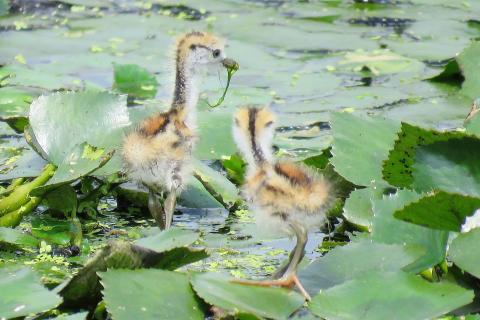A steadily growing population of pheasant-tailed jacanas in the Tainan region has given rise to a project to promote farming practices that could create more habitable land for the birds.
The Wild Birds Society of Tainan, the Guantian Pheasant-tailed Jacana Ecological Park, the Forestry Bureau’s Tainan branch and the Tainan City Government are collaborating on the project.
According to the ecological park, a subsidiary of the Siraya National Scenic Area, the jacana population has been steadily increasing, averaging more than 500 for four consecutive years.

Photo: Yang Chin-cheng, Taipei Times
This year, the population has spiked to 910, the park said.
The mating season for the pheasant-tailed jacana falls between May and September, and the birds usually find a spot to build their nests by July, park Director Lee Wen-chen (李文珍) said, adding that this helps the park tally the population.
Student volunteers from National Cheng Kung University, the National University of Tainan and National Chiayi University help the park log the number of jacanas mating in the Tainan area, which increased 6 percent from last year, Lee said.
The majority of jacanas — about 78 percent — mated in Guantian District (官田), a renowned production area for water chestnuts that is well-suited for the species, Lee said, adding that water shortages in May and June appear not to have had an adverse effect on the jacanas.
More than 80 percent of all adult and young jacanas, as well as their eggs, have been found near water chestnut fields, showing that the birds have a strong preference for that habitat, Lee said.
Siaying District (下營) has the second-largest cluster of jacanas in the region at 10 percent, Lee said.
The birds used to be found across the nation, but their habitat has gradually shrunk due to land development.
It is now only seen in water chestnut fields between Bajhang Creek (八掌溪) and the Zengwen River (曾文溪).
The bird was declared a grade-two endangered species in 1989 and adopted as Tainan’s official bird.

Taiwan is to commence mass production of the Tien Kung (天弓, “Sky Bow”) III, IV and V missiles by the second quarter of this year if the legislature approves the government’s NT$1.25 trillion (US$39.78 billion) special defense budget, an official said yesterday. Commenting on condition of anonymity, a defense official with knowledge of the matter said that the advanced systems are expected to provide crucial capabilities against ballistic and cruise missiles for the proposed “T-Dome,” an advanced, multi-layered air defense network. The Tien Kung III is an air defense missile with a maximum interception altitude of 35km. The Tien Kung IV and V

The disruption of 941 flights in and out of Taiwan due to China’s large-scale military exercises was no accident, but rather the result of a “quasi-blockade” used to simulate creating the air and sea routes needed for an amphibious landing, a military expert said. The disruptions occurred on Tuesday and lasted about 10 hours as China conducted live-fire drills in the Taiwan Strait. The Civil Aviation Administration (CAA) said the exercises affected 857 international flights and 84 domestic flights, affecting more than 100,000 travelers. Su Tzu-yun (蘇紫雲), a research fellow at the government-sponsored Institute for National Defense and Security Research, said the air

A strong continental cold air mass is to bring pollutants to Taiwan from tomorrow, the Ministry of Environment said today, as it issued an “orange” air quality alert for most of the country. All of Taiwan except for Hualien and Taitung counties is to be under an “orange” air quality alert tomorrow, indicating air quality that is unhealthy for sensitive groups. In China, areas from Shandong to Shanghai have been enveloped in haze since Saturday, the ministry said in a news release. Yesterday, hourly concentrations of PM2.5 in these areas ranged from 65 to 160 micrograms per cubic meter (mg/m³), and pollutants were

Taiwan’s armed forces have established response protocols for a wide range of sudden contingencies, including the “Wan Chun Plan” to protect the head of state, the Ministry of Defense (MND) said today. After US President Donald Trump on Saturday launched a series of airstrikes in Venezuela and kidnapped Venezuelan President Nicolas Maduro, concerns have been raised as to whether China would launch a similar “decapitation strike” on Taiwan. The armed forces regularly coordinate with relevant agencies and practice drills to ensure preparedness for a wide range of scenarios, Vice Minister of National Defense Hsu Szu-chien (徐斯儉) told reporters before a